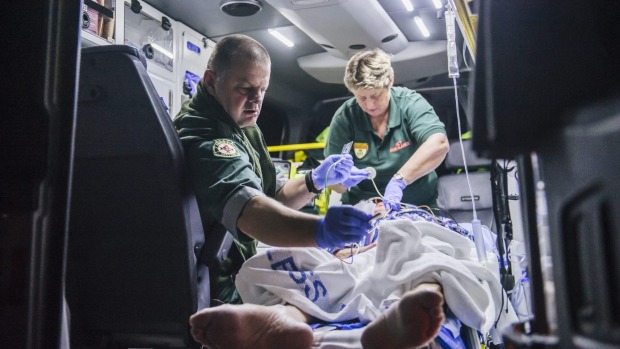
Intensive care paramedics treat a 79-year-old ACT man in the back of an ambulance. Photo: Rohan Thomson.
The number of older Australians hospitalised after falls continues to increase due to an ageing population, placing additional demand on the health sector.
More than half of the 170,000 people admitted to Australian hospitals after falls during 2012-13 were older than 65, with older women more likely to injure themselves than men.
The data, published by the Australian Institute of Health and Welfare on Wednesday, is the latest sign of hospitals having to optimise their services for an ageing population.
Professor James Harrison, who co-wrote the report and chairs the AIHW’s National Injury Surveillance Unit, said the admissions placed strain on hospitals and the healthcare system.
“This represents an increasing burden on already busy institutions, and it’s not a new challenge. We began reporting on the increasing rate of falls a decade or so ago,” he said.
“The Australian Bureau of Statistics projects that the size of the older population will continue to rise for another decade, so the pattern we are seeing is likely to increase.”
According to government figures, the number of Australians aged older than 65 is expected to increase from 2.5 million in 2002 to 4.2 million in 2021, or 18 per cent of the overall population.
The AIHW report found that hospital admissions after falls increased by 2 per cent during 2012-13, with experts warning the trend will continue in coming years.
“The data on hospital admissions would tell a different story if we were in the 1960s when the baby boomer generation was younger, as the population bulge shapes the findings,” Professor Harrison said.
An earlier AIHW report found that the number of hospital admissions for people aged older than 85 increased by 9 per cent each year between 2007 and 2012, which was double the overall rate.
Dr Judith Healy, a visiting fellow at the Australian National University, said Australian hospitals could learn from many European nations that have embraced age-friendly hospitals.
“Hospitals can be risky places for older people, and it is important to make them more accessible and safe for the frail with rails and clear signs, and reduce the possibility of people tripping and falling,” she said.
The latest AIHW report also stated that older Australians spent more time in hospitals after injuring themselves.
In 2012-13, the average length of stay in hospitals after an injury was four days – or more than 1.7 million days a year – while this increased to seven days for those aged older than 65.
Men were more likely to injure themselves than women in every demographic until the 65-and-older category, where the trend was reversed.
Woman aged 85 and older were most likely to injure themselves, with 12,431 cases per 100,000 population, compared to 8,911 for males at the same age.
“The dominance of females in these older categories is mainly because women live longer than men in Australia,” Professor Harrison said.
“When you get to the age where people are at most risk of falling, a large proportion of men have already died.”
Injuries also proved more serious for older Australians, with 29 per cent of cases considered life-threatening for those older than 65 compared to 16 per cent for younger Australians.
Australians over 65 were most likely to fall from slipping, tripping or stumbling, while only 1.7 per cent fell down stairs.
